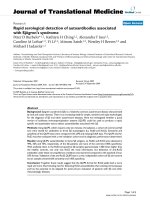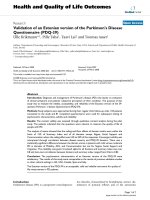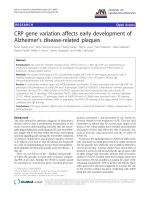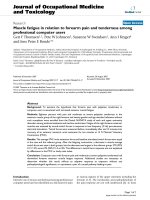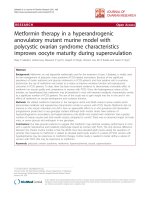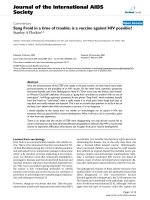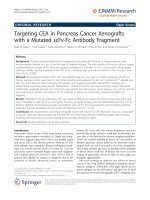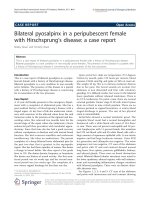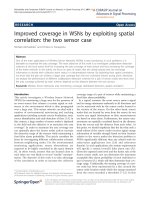Báo cáo hóa học: " Bilateral pyosalpinx in a peripubescent female with Hirschsprung’s disease: a case report" docx
Bạn đang xem bản rút gọn của tài liệu. Xem và tải ngay bản đầy đủ của tài liệu tại đây (2.01 MB, 3 trang )
CAS E REP O R T Open Access
Bilateral pyosalpinx in a peripubescent female
with Hirschsprung’s disease: a case report
Bobby Desai
*
and Timothy Ward
Abstract
This is a case report of bilateral pyosalpinx in a peripubescent female with a history of Hirschsprung’s disease.
Bilateral pyosalpinx is a rare condition in non-sexually active females. The presence of this disease in a patient with
a history of Hirschsprung’s disease is concerning for an association of the two processes.
Introduction
This is a case report of bilateral pyosalpinx in a peripu-
bescent female with a history of Hirschsprung’ s disease.
Bilateral pyosalpinx is a rare condition in non-sexually
active females. The presence of this disease in a patient
with a history of Hirschsprung’s disease is concerning
for an association of the two processes.
Case Report
A 12 year old female presents to the emergency depart-
ment with a complaint of abdominal pain. She has a
past medical history of Hirschsprung’sdiseasewitha
staged repair. At day four of life s he underwent colost-
omy with resection of t he affected colon from the mid
transverse colon to the junction of the sigmoid and des-
cending colon. She returned two months l ater for the
second stage of the repair where she underwent a Soave
endorectal pull thru proce dure with incidental appen-
dectomy. Since that time she has had a good recovery
without constipation or diarrhea and with normal bowel
function. She had recurrent tonsillitis and underwent
tonsillectomy. She takes no medications. The patient
complains of a sharp bilateral lower abdominal pain for
the past two days that is greatest in the suprapubic
region. She has had three episodes of emesis. She denies
a change in bowel habits. She does report a low g rade
fever to 101. She denies dysuria, frequency or hematuria.
She denies any history of sexual activity. Her first men-
strual period was six weeks ago and her second men-
strual period was two weeks ago. She complains of a
new watery vaginal discharge for less than one day.
Upon arrival her vitals are temperature 37.2 degrees
Celsius by mouth, pulse 125 beats per minute, blood
pressure 124/64 mm/Hg, and pulse ox 96% on room air.
She weighs 45 kg. She is in obvious moderate distress
due to her pain. Her bowel sounds a re normal. Her
abdomen i s non distended and firm with vo luntary
guarding. It is diffusely tender, but worse in the bilateral
lower quadrants without rebound tenderness. There is
no CVA te nderness. On pelvic exam, there are normal
external genitalia Tanner stage II-III with intact hymen
from six o ’clock to nine o’clock position. There are no
obvious perineal or vaginal lacer ations. A watery blood
tinged discharge is present. The rest of her physical
exam is unremarkable.
Initial labs showed a normal metabolic panel. The
complete blood count had a normal hemoglobin and
hematocrit with a white blood cell count of 14.5 thou/
cu mm. There were 64 percent neutrophils and 18 per-
cent lymphocytes with 11 percent bands. Her urinalysis
had 219 red blood cells and 85 white blo od cells with a
large amount of squamous epithelial cells. It was nitrite
negative and had large leukocyte esterase. Urine PCR
for gonorrhea and chlamydia was negative. The urine
pregnancy test was negative. CT scan of the abdomen
and pelvis with IV and oral contrast showed normal
lung bases, liver, spleen, pancreas, gallbladder, kidneys,
and adrenal glands. There were no bowel obstruction
noted. Bilateral dilated tubular structures were noted in
the lower quadrants, adnexal regions, with wall enhance-
men t and surrounding inflammatory chang es consistent
with bilateral pyosalpinx. There were no distinct drain-
able abscesses seen.
See Figures 1, 2, 3, 4 and 5: CT scan of the abdomen
and pelvis with intravenous and oral contrast showing
* Correspondence:
University of Florida, Department of Emergency Medicine, PO Box 100186,
Gainesville, FL 32610, USA
Desai and Ward International Journal of Emergency Medicine 2011, 4:64
/>© 2011 Desai and Ward; licensee Spri nger. This is an Open Acc ess article distri buted under the terms of the Creative Commons
Attribution License (http://creativecomm ons.org/licenses/by/2.0), which permits unrestricted use, distribution, and reproductio n in
any medium, provided the original work is prop erly cited.
bilateral dilated fallopian tubes with pronounced wall
enhancement
She received IV fluid s and morphine for pai n control,
and she was admitted to gynecology service for IV anti-
biotics. In the hospital she received IV Ampicillin, Gen-
tamicin, and Fla gyl for four days until she was afebrile
for forty eight hours and had a normal white count. She
was discharged on a ten day course of Doxycycline and
Flagyl with Motrin for pain control. At six month tele-
phone follow up she denies any r ecurrence of her
symptoms.
Discussion
The presentation of a 12 year old, who is not sexually
active, with bilateral pyosalpinx and a history of Hirsch-
sprung’s disease is extremely rare. The pathology and
anatomical location of these two diseases processes sug-
gest that they may be associated.
Hirschsprung disease is an uncommon congenital dis-
order that affects 1 in 5000 of live births. The disease is
characterized by the absence of ganglion cells in the dis-
tal colon including t he anus. It results from incomplete
migration of neural crest cells or early cell death. There
have been eight genes identified that are associated with
Hirschsprung disease and the disease has been asso-
ciated with other congenital abnormalities. Five percent
of all cases are associated with Down syndrome [1]. In
one prospective study 25 percent of Hirschsprung
patients were also found to have congenital abnormal-
ities of the kidney and genital track, the most common
abnormalities being hydronephrosis and hypoplasia [2].
The association of hydrosalpinx and Hirschsprung’s
disease was previously suggested in 2007 by Merlini et
al. In this case series the author suggest that bilateral
hydrosalpinges is a associated abnormality of Hirsch-
sprung’s disease due to neurocristopathy. The paper also
Figure 1 CT scan of the abdomen and pelvis with intravenous
and oral contrast. Bilateral dilated fallopian tubes with pronounced
wall enhancement are shown.
Figure 2 CT scan of the abdomen and pelvis with intravenous
and oral contrast. Swelling and inflammation are shown around
the fallopian tube.
Figure 3 CT scan of the abdomen and pelvis with intravenous
and oral contrast. Inflammation is demonstrated.
Figure 4 CT scan of the abdomen and pelvis with intravenous
and oral contrast. A lower cut on the CT scan demonstrating
extension of inflammation.
Desai and Ward International Journal of Emergency Medicine 2011, 4:64
/>Page 2 of 3
discusses the possibility that the disease process could
be a complication from the surgical repair. This is the
only article that was found in a pubmed search from
1980-present which discusses hydrosalpinx or pyosal-
pinx in association with Hirschsprung disease [3].
Pyosalpinx is the acute inflammation of the salpinx
which is most commo nly caused by gonorrhea. Other
well described causes of pyosalpinx are Chlamydia and
enteric bacteria [1]. Hydrosapinx has been associated
with less common organisms including pneumococcus,
streptococcus, and shigelloides and is seen in non sexu-
ally active females [4-7]. Both pyosalpinx and hydrosal-
pinx have been reported to present at menarche i n
females with underlying urogenital malformations [8].
In this case the patient presented just prior to her sec-
ond menstrual period with pyosalpinx that was con-
firmed by CT exam. She had complete resolution of
symptoms with IV and PO antibiotics and did not have
return of symptoms at six month follow up. It is reason-
able to speculate that her underlying Hirschsprung’s dis-
ease attributed to this condition.
Consent
Written informed consent was obtained from the par-
ents of the patient for publication of this Case report
and any accompanying images. A copy of the written
consent is available for review by the Editor-in-Chief of
this journal.
Authors’ contributions
TW & BKD: Wrote and edited case report
Competing interests
The authors declare that they have no competing interests.
Received: 5 May 2011 Accepted: 12 October 2011
Published: 12 October 2011
References
1. Kumar V, Abbas AK, Fausto N: Robbins and Cotran Pathologic Basis of
Disease. Elsevier Saunders;, 7830-831, 1064-1065.
2. Pini Prato A, Musso M, Ceccherini I, Mattioli G, Giunta C, Ghiggeri GM,
Jasonni V: Hirschsprung disease and congenital anomalies of the kidney
and urinary tract (CAKUT): a novel syndromic association. Medicine
(Baltimore) 2009, 88(2):83-90.
3. Merlini L, Anooshiravani M, Peiry B, La Scala G, Hanquinet S: Bilateral
hydrosalpinx in adolescent girls with Hirschsprung’s disease -
association of two rare conditions. AJR 2008, 190:278-282.
4. Casiro OG, Gochberg F, Drachman R: Pneumococcal pyosalpinx in a
prepubertal child. Isr J Med Sci 1980, 16(12):865-6.
5. Hornemann A, von Koschitzky H, Bohlmann MK, Hornung D, Diedrich K,
Taffazoli K: Isolated pyosalpinx in a 13-year-old virgin Fertil Steril. 2009,
91(6):2732.e9-10.
6. Roth T, Hentsch C, Erard P, Tschantz P: Pyosalpinx: not always a sexual
transmitted disease? Pyosalpinx caused by Plesiomonas shigelloides in
an immunocompetent host. Clin Microbiol Infect 2002, 8(12):803-5.
7. Meis JF, Festen C, Hoogkamp-Korstanje JA: Pyosalpinx caused by
Streptococcus pneumoniae in a young girl. Pediatr Infect Dis J 1993,
12(6):539-40.
8. Mollitt DL, Schullinger JN, Santulli TV, Hensle TW: Complications at
menarche of urogenital sinus with associated anorectal malformations. J
Pediatr Surg 1981, 16(3):349-52.
doi:10.1186/1865-1380-4-64
Cite this article as: Desai and Ward: Bilateral pyosalpinx in a
peripubescent female with Hirschsprung’s disease: a case report.
International Journal of Emergency Medicine 2011 4:64.
Submit your manuscript to a
journal and benefi t from:
7 Convenient online submission
7 Rigorous peer review
7 Immediate publication on acceptance
7 Open access: articles freely available online
7 High visibility within the fi eld
7 Retaining the copyright to your article
Submit your next manuscript at 7 springeropen.com
Figure 5 CT scan of the abdomen and pelvis with intrave nous
and oral contrast. Abscess is shown.
Desai and Ward International Journal of Emergency Medicine 2011, 4:64
/>Page 3 of 3
